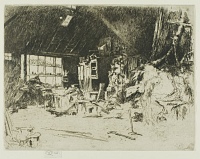Etchings Institutions search term: grolier club
The Smithy | ||
| Number: | 239 | |
| Date: | 1880 | |
| Medium: | etching and drypoint | |
| Size: | 177 x 229 mm | |
| Signed: | butterfly at lower right | |
| Inscribed: | no | |
| Set/Publication: | no | |
| No. of States: | 6 | |
| Known impressions: | 20 | |
| Catalogues: | K.240; M.237; W.197 | |
| Impressions taken from this plate (20) | ||
PUBLICATION
EXHIBITIONS
"His Etchings seem weak when framed." P. G. Hamerton.
8: London FAS 1883 (cat. no. 34).
9: 'Mr. Whistler's Etchings', The Globe, 19 February 1883, GUL PC25/19.
10: St James Gazette, 20 February 1883 (GUL PC25/30, PC7/31).
Bryan Lathrop (1844-1916) lent another impression to the exhibition organised by the Caxton Club in Chicago in 1900 (
 ). 13 In 1900 Whistler tried to borrow an impression back from Edward Guthrie Kennedy (1849-1932) to include in a group of etchings for the Universal Exhibition in Paris, but it would appear this was not possible. 14 However, in 1901 an impression was exhibited at an International Exhibition in Dresden, bought for the gallery, and exhibited again in the following year among new acquisitions. 15
). 13 In 1900 Whistler tried to borrow an impression back from Edward Guthrie Kennedy (1849-1932) to include in a group of etchings for the Universal Exhibition in Paris, but it would appear this was not possible. 14 However, in 1901 an impression was exhibited at an International Exhibition in Dresden, bought for the gallery, and exhibited again in the following year among new acquisitions. 15
Print dealer's shows included H. Wunderlich & Co. in New York in 1898 and 1903, and Obach & Co. in London, also in 1903. 16
11: 15 May 1893, GUW #04002; Chicago 1893 (cat. no. 2255 [1670]).
12: Boston 1904 (cat. no. 152).
13: Chicago 1900 (cat. no. 175).
14: [12/15 February 1900], GUW #09799.
15: Dresden 1901 ; Dresden 1902 .
16: See REFERENCES: EXHIBITIONS.
 ,
,  ,
,  , and
, and  ) but there is no way to tell which she selected for exhibition.
) but there is no way to tell which she selected for exhibition.17: Rotterdam 1906 (cat. no. 45).
SALES & COLLECTORS
On 18 July of that year Whistler noted that he had one in stock, but he must have printed more. 20 On 6 April 1891 he sold one to H. Wunderlich & Co. of New York for an intermediate price, £8.8.0. 21 This was almost certainly the one bought by Charles Lang Freer (1856-1919) from Wunderlich's in 1891 (
 ).
). 22: [17 June 1892], #09684.
23: 12 April 1893, GUW #07214.
24: 20 February 1894, GUW #07231.
25: [12/15 February 1900], GUW #09799.
 ) among an assortment of 8 etchings and a lithograph, to the Königl. Kupferstichkabinett Dresden for £50.0.0.
) among an assortment of 8 etchings and a lithograph, to the Königl. Kupferstichkabinett Dresden for £50.0.0. Early British collectors included John Charles Sigismund Day (1826-1908) (
 ,
,  ), Joshua Hutchinson Hutchinson (ca 1829 - d.1891) (
), Joshua Hutchinson Hutchinson (ca 1829 - d.1891) ( ,
,  ,
,  ), and the Royal Collection at Windsor Castle (
), and the Royal Collection at Windsor Castle ( ). In 1894 an impression at the J.M. Gray sale which 'seemed unfinished' fetched £2.7.6. 26 American collectors included Samuel Putnam Avery (1822-1904) (
). In 1894 an impression at the J.M. Gray sale which 'seemed unfinished' fetched £2.7.6. 26 American collectors included Samuel Putnam Avery (1822-1904) ( ), George Aloysius Lucas (1824-1909) (
), George Aloysius Lucas (1824-1909) ( ) and Bryan Lathrop (1844-1916) (
) and Bryan Lathrop (1844-1916) ( ) as well as Freer, as mentioned above.
) as well as Freer, as mentioned above.Hutchinson's etchings went to auction after his death. The 'first trial proof' (probably
 ) and the 'second trial proof' (possibly
) and the 'second trial proof' (possibly  ) were sold at Sotheby's, 3 March 1892 (lots 295, 296) and bought by Frederick Keppel (1845-1912) of F. Keppel & Co., for £2.18.0 and £3.0.0 respectively.
Lot 297, the 'third trial proof' (possibly
) were sold at Sotheby's, 3 March 1892 (lots 295, 296) and bought by Frederick Keppel (1845-1912) of F. Keppel & Co., for £2.18.0 and £3.0.0 respectively.
Lot 297, the 'third trial proof' (possibly  ) was bought for the same sum by the London print dealer,Robert Dunthorne (b. ca 1851). Lot 298, the 'fourth trial proof' also went to Keppel, for £3.5.0.
Lot 299, 'fifth trial proof, touched' was bought by Whistler's friend, the lithographic printer Thomas Way (1837-1915) for £3.5.0 and sold by him in 1905 to Charles Lang Freer (1856-1919) (
) was bought for the same sum by the London print dealer,Robert Dunthorne (b. ca 1851). Lot 298, the 'fourth trial proof' also went to Keppel, for £3.5.0.
Lot 299, 'fifth trial proof, touched' was bought by Whistler's friend, the lithographic printer Thomas Way (1837-1915) for £3.5.0 and sold by him in 1905 to Charles Lang Freer (1856-1919) ( ). Finally, Lot 300, the 'sixth trial proof' was bought by 'Helbridge' for £1.18.0.
). Finally, Lot 300, the 'sixth trial proof' was bought by 'Helbridge' for £1.18.0.26: 'J.M. Gray sale', The Academy, 17 November 1894, p. 405.
